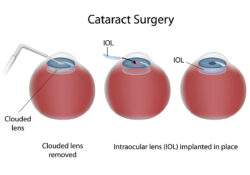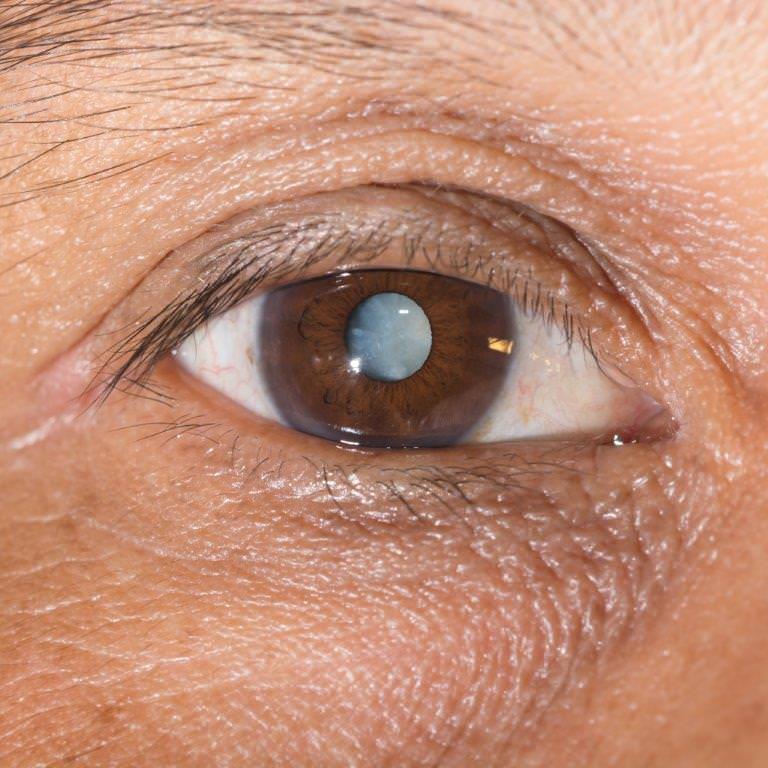
Suffering from cataracts in the Kansas City, MO area? Sick of living with reduced vision and ready to take your life back? The talented team at Wiles Eye Center are experts at treating cataracts. We understand the inconvenience of poor vision and work hard to offer all our St. Joseph and Kansas City, MO cataract patients high quality, affordable cataract removal procedures. Dr. Stephen Wiles, chief ophthalmologist, is one of the nation’s top eye surgeons. Dr. Wiles has a 99.9% success rate in cataract surgeries without unplanned complications. Dr. Wiles uses refined surgical techniques that minimize invasiveness and increase the speed of recovery for our patients.
What Are Cataracts?
A cataract is a clouding of the eye’s naturally clear lens. When the lens becomes cloudy, vision cannot pass through it properly, and images are blurred. Cataracts are, for the most part, a normal consequence of aging. Sunlight, genetics, medications, diabetes, trauma, and smoking all contribute to cataract formation. Depending on the severity of the clouding, patients can experience slightly blurred vision to near blindness. Patients who struggle with cataracts often experience:
- Blurred vision
- Increased sensitivity to sun or artificial light
- Increased glare
- Dull colors
Types of Cataracts
Most cataracts develop from natural changes as you age, with proteins inside the eye lens clumping together to form a cloudy appearance that gradually obstructs vision. However, many types of cataracts may appear throughout life.
 Age-related cataracts: Most people develop cataracts by their mid-70s, but smokers, heavy drinkers, people taking steroids, or those with a history of eye surgery or cataracts in their family are at higher risk.
Age-related cataracts: Most people develop cataracts by their mid-70s, but smokers, heavy drinkers, people taking steroids, or those with a history of eye surgery or cataracts in their family are at higher risk.
Radiation cataracts: Radiation exposure from cancer treatment or ultraviolet (UV) light may cause cataracts.
Traumatic cataracts:A severe eye injury may damage the internal eye lens and lens capsule surrounding it, causing a cataract to form much sooner in life.
Secondary cataracts: After cataract surgery, scar tissue may grow in the lens capsule and cause cloudy vision again. This type is called posterior capsule opacification and is treated quickly and painlessly with YAG laser capsulotomy.
Pediatric cataracts: Some children are born with cataracts, while other kids may develop them later on. Pediatric cataracts are rare and usually genetic but may also happen after childhood illness or problems during pregnancy. Eye injury, radiation, and steroids are also risk factors for children.
Some cataracts form differently than others and are also broken into sub-types, including:
Nuclear sclerotic cataracts: These growths develop slowly with a gradual yellowing and hardening in the center of the lens (or nucleus) that expands. This type of cataract may temporarily improve vision; this is called “second sight” and takes years to worsen and cause impairment.
Cortical cataracts: These clumps form in the cortex layer of the lens and extend inward toward the center, scattering light and affecting vision with glare, decreased contrast, poor depth perception, and blurred vision. People living with diabetes are more likely to have cortical cataracts.
Posterior subcapsular cataracts: These cataracts affect reading and night vision and grow on the back (posterior) of the lens under the small sac housing the lens, causing glare, halos, and other visual disturbances. People taking steroids or with diabetes, extreme myopia, and retinitis pigmentosa are at higher risk.
Symptoms of Cataracts
 Cataract symptoms start small, with only a portion of the eye lens affected by the cloudy appearance. You may not notice any vision loss until the cataract grows larger and denser. The denser the cataract, the less light can pass through the lens onto the retina and the more severe your symptoms and vision loss. Eye exams at Wiles Eye Center can catch cataracts early — before severe symptoms.
Cataract symptoms start small, with only a portion of the eye lens affected by the cloudy appearance. You may not notice any vision loss until the cataract grows larger and denser. The denser the cataract, the less light can pass through the lens onto the retina and the more severe your symptoms and vision loss. Eye exams at Wiles Eye Center can catch cataracts early — before severe symptoms.
- Dim vision
- Blurry vision
- Clouded eyesight
- Challenges seeing at night
- Glare
- Light sensitivity
- Halos around lights
- Frequent vision changes or prescription updates
- Muted or yellowing colors
- Double vision
- Blindness (if left untreated)
Some people with cataracts must adjust their homes and workplaces by switching dim lamps with brighter bulbs or lights so they can read and complete fine-detail tasks.
What is Cataract Removal Surgery?
Many people hear the terms “cataract” and “cataract removal” but might not understand what a cataract is and why it deteriorates your vision. You can watch the video above to see a simple analogy that explains what cataracts are, and how they impede sight.
Cataract removal is the surgical process of removing the blurred portion of cornea, to alleviate blurred vision. At our Kansas City, MO vision center, our doctors perform cataract removal with either a scalpel or a laser.
How to Prepare for Cataract Surgery
 Discuss your complete medical history with Dr. Wiles during your eye exam and appointment. Cataract surgery may require some lifestyle modifications. For example, people with diabetes need to manage their blood sugar levels before proceeding with cataract surgery. Medications for prostate problems can also interfere with the procedure.
Discuss your complete medical history with Dr. Wiles during your eye exam and appointment. Cataract surgery may require some lifestyle modifications. For example, people with diabetes need to manage their blood sugar levels before proceeding with cataract surgery. Medications for prostate problems can also interfere with the procedure.
Dr. Wiles will discuss the do’s and don’ts for the days leading up to and after your cataract procedure. You may need to avoid taking aspirin and other anti-clotting medications, and a 12-hour fast from food and water is often required. Don’t wear contact lenses for several days beforehand, and stay away from makeup, lotions, creams and other face and eye products the day of your cataract surgery.
How is Cataract Surgery Performed?
Using a high-powered microscope, the cataract is gently removed with an ultrasonic probe through an opening so small that it heals without any stitches. A custom-designed lens implant, called an intraocular lens (IOL), is placed into your eye in order to restore bright, clear vision. The newest IOLs allow you to see far away, up close, and in between without glasses. These advanced techniques have been perfected over thousands of cases. It is pain free, uses eye drops for anesthetic (no needles), and requires no stitches for most patients. These amazing refinements allow you to go home within minutes of the treatment without eye patches and begin to enjoy your new vision.
Highly-trained in advanced cataract surgery techniques, our experienced eye surgeons replace clouded lenses with leading-edge intraocular lens implants to help patients achieve crystal-clear vision. They use only the finest implants, like the Crystalens AO accommodating IOL. Crystalens IOL is an FDA-approved intraocular lens that has been approved by the FDA to treat patients suffering from presbyopia. At Wiles Eye Center, patients can also select from other options to improve seeing from a distance, such as the Bausch and Lomb H60, AMO Tecnis, Alcon’s ReSTOR Multifocal lens, and or the AO intraocular lens. Contact our office to learn about even more IOL options.
We perform most cataract surgery in specialized outpatient facilities.
Dr. Wiles restores sight to a blind man
Types of Intraocular Lens Implants
 Traditional cataract surgery replaces the clouded natural eye lens with a monofocal intraocular lens implant (IOL) that improves vision by restoring the optical pathway. Many people need prescription glasses after cataract surgery with monofocal lenses because these implants don’t address their pre-existing refractive errors. If you have presbyopia (age-related loss of near vision), farsightedness, nearsightedness or astigmatism, a premium IOL is likely a better fit for your eyesight.
Traditional cataract surgery replaces the clouded natural eye lens with a monofocal intraocular lens implant (IOL) that improves vision by restoring the optical pathway. Many people need prescription glasses after cataract surgery with monofocal lenses because these implants don’t address their pre-existing refractive errors. If you have presbyopia (age-related loss of near vision), farsightedness, nearsightedness or astigmatism, a premium IOL is likely a better fit for your eyesight.
The newest IOLs offer enhanced eyesight on all fronts — near, middle and far distances — without prescription lenses or glasses. These custom IOLs are fit precisely to your eye to ensure sharp, clear vision:
- Multifocal IOLs: Multifocal lenses allow vision correction for refractive errors. These IOLs free you from glasses and contact lenses, so you have crisp eyesight at short and long distances. Wiles Eye Center in Kansas City offers Tecnis Symfony and ReSTOR multifocal lenses for cataract patients. Symfony IOL may be best for those with coexisting eye disease and presbyopia.
- Vivity IOL: If you spend a lot of time in the sun or on devices, Vivity IOL may be a good fit for your needs. This intraocular lens implant absorbs UV rays from sun exposure and filters harmful blue light from digital devices, reducing eyestrain. Vivity IOL is suitable for those who drive at night or need to see clearly in low lighting.
- PanOptix Trifocal: PanOptix Trifocal is the only IOL that provides clear vision at intermediate distances (in addition to near and far) and is an excellent option for an active person whose eyes need to be able to adjust to focus on objects at various distances during activities such as golf.
- Crystalens Accommodating IOL: This IOL moves with the eye’s ciliary muscle for improved focus and vision when transitioning from looking at an object nearby to one farther away. Crystalens can effectively treat presbyopia.
Toric variations of monofocal and premium IOLs are available to treat astigmatism.
What to Expect During Cataract Surgery Recovery
Our Kansas City eye surgeon offers dropless cataract surgery, so you won’t need to worry about antibiotic and anti-inflammatory eye drops before and after the procedure. However, you won’t be able to drive at first. Make sure you have someone available to help you get home and settled in where you have easy access to the kitchen and restroom. You’ll need to take a few days away from work to rest and recover, but most people can resume regular activities after that point.
Your treated eye may feel itchy and uncomfortable for several days, but do not rub or push on the eye. Dr. Wiles will provide a protective eye shield to wear during the first few days of your recovery and while you sleep to avoid irritating the eye and risking infection.
Most patients are healed entirely after eight weeks, but colors will appear brighter right after cataract surgery.
Attend all follow-up appointments in the days, weeks and months after cataract surgery.
Is Cataract Surgery Right For You?
Cataract surgery is one of the most successful procedures performed in the United States. Almost everyone’s vision improves and side effects are rare. Although you can live with cataracts for a period of time, it is usually safer and easier on you to remove them before they advance to severe vision loss. Cataracts should be removed when you want to see better, and when we anticipate significant visual improvement from the procedure. Our doctors and staff are dedicated, experienced cataract surgery professionals and will be able to help you decide if a cataract surgery procedure is right for you. Our staff is also available to answer the many questions you may have like:
- Can I wear makeup after cataract surgery?
- Are you awake during cataract surgery?
- Can I go swimming after cataract surgery?
What is Micro-Touch Advanced Cataract Surgery?
Dr. Stephen B. Wiles uses techniques that he pioneered himself, to gently remove the cataract through a very small opening in the eye. This surgical incision is so small, that it heals on its own without the need for stitches. Then a custom-designed intraocular lens (or IOL) is placed into the eye to restore your vision. Many of the newer implants allow patients to see without the need for glasses.
Cataract surgery is one of the most successful surgical procedures in the United States. In its history, cataract surgery been perfected through more than a hundred thousand successful cases. Micro-Touch Advanced Cataract Surgery takes this success even further, in two important ways. It is pain-free, uses eye drops to administer an anesthetic (no needles required), and normally requires no stitches or eye patches. Micro-Touch Advanced Cataract Surgery is 66% more efficient. This means the surgery can be performed in less time, is a safer procedure, and has better results than traditional cataract surgery.
What Is Dropless Cataract Surgery?
Patients who undergo traditional cataract surgery are responsible for instilling numerous eye drops in the days and weeks following the procedure. These drops, which usually consist of steroid, antibiotic and anti-inflammatory medications, protect the healing eyes against post-operative complications, such as inflammation and infection. Patients may need to use as many as 12 eye drops per day.
It can be quite labor intensive for our patients to remember to use the drops every day and apply them correctly. Many patients have a hard time keeping track of the different drops and remembering the proper dosing regimen. Some do not feel confident in their ability to correctly use the drops because of physical limitations due to rheumatoid arthritis or Parkinson’s disease that make it challenging to open the small bottles and maneuver the drops into the eyes.
Furthermore, the cost of the drops can be a financial burden. Some patients try to stretch their drops to avoid getting refills, but this can be risky to healing eyes.
Dropless cataract surgery eliminates the need for this cumbersome and costly post-operative eye drop regimen. At the end of the dropless cataract procedure, while the patient is still numbed, the surgeon administers antibiotic and steroid injections directly to the eyes. After surgery, the patient can focus on recovery and not the inconvenience of the eye drop routine.
At Wiles Eye Center, we believe that dropless cataract surgery presents significant value to our patients.
Benefits of Dropless Cataract Surgery
- Injections eliminate the stress, burden or discomfort of properly applying numerous eye drops in the days and weeks following surgery
- Injections offer the same protection against post-operative complications such as infection and inflammation
- There is no chance of getting an infection from a contaminated dropper bottle or from touching the eyes
- Lower cost compared to the expense of numerous different eye drops
The majority of patients are candidates for dropless cataract surgery. Contact Wiles Eye Center today for more information about the procedure.
Cataract Surgery Cost
The cost of cataract surgery can vary by practice and even from patient to patient. The total cost of your cataract surgery will reflect the type of procedure you undergo as well as the type of IOL used to restore your vision.
Generally the advanced forms of cataract surgery, such as laser-assisted cataract surgery, are more expensive than traditional cataract surgery. Choosing a premium IOL will also add to the total cost of surgery (while offering incredible value and benefits!).
Does Insurance Cover Cataract Surgery?
Most medical insurance plans cover the cost of traditional cataract surgery with the placement of a basic monofocal IOL (i.e., an IOL that replaces vision at a single fixed distance). If you wish to upgrade to laser-assisted cataract surgery or a premium IOL that reduces your dependence on glasses and contacts, expect higher out-of-pocket costs.
Our team can go over the exact cost of your cataract surgery, factoring in any insurance coverage, during your initial consultation. We will break down what is and is not included in your price quote and answer any questions you have about cost, insurance and financing options.
Cataract Myths and Misconceptions
People have lost their vision to cataracts throughout the ages, and the long history of this eye disease means there are many myths to dispel about the cause as well as treatment. Some of the common misconceptions we hear at Wiles Eye Center in Kansas City include:
Myth 1: Cataracts Can Spread from One Eye to the Other
This eye disease does not spread and is not contagious. While cataracts may develop in both eyes around the same time, these are separate events that occur when the proteins in your eye’s lens clump together.
Myth 2: Cataract Surgery Is Only for Advanced Cataracts
There once was some truth to this myth, as early cataract procedures did require severe lens clouding before surgery. However, advanced technology has allowed eye surgeons to remove cataracts early, well before severe vision loss.
Myth 3: Cataracts Will Grow Back If Removed
Cataract surgery removes the clouded eye lens from your eye and replaces it with an IOL. The artificial lens can’t form a cataract. However, “secondary cataract” may rarely occur, which is when the back of the lens capsule containing the IOL accumulates proteins and causes some vision disturbance.
Why Choose Wiles Eye Center
Wiles Eye Center uses state-of-the-art technology in the hands of board-certified eye surgeons for the highest standard of care and optimal results. Our Kansas City eye doctors are leaders in ophthalmology, and our Chief Ophthalmologist, Dr. Stephen B. Wiles, is one of the most renowned and successful cataract surgeons in the United States. Dr. Wiles has perfected a cataract surgery technique that promotes faster healing and has served the Kansas City area for more than 40 years.
Our eye doctors and trained staff provide high-quality eye care in a friendly, caring environment emphasizing patient education. Your eye health and vision are our top priorities.
Visit Wiles Eye Center for a Dropless Cataract Surgery Consultation
At Wiles Eye Center, our goal is to provide the right cataract treatment for your individual lifestyle. Serious complications are extremely rare but because it is a form of surgery, there are some potential risks involved. Our staff and cataract surgeons will provide you with additional information about the risks associated with cataract surgery and answer any of the questions you may have.
Frequently Asked Questions About Cataracts
 Have questions about cataract surgery? The surgeons at our Kansas City, MO vision center know it’s natural for candidates to have questions about the surgical procedure. Read the list below to learn our top nine most frequently asked questions. If your question doesn’t appear here, feel free to submit your own by sending us an email.
Have questions about cataract surgery? The surgeons at our Kansas City, MO vision center know it’s natural for candidates to have questions about the surgical procedure. Read the list below to learn our top nine most frequently asked questions. If your question doesn’t appear here, feel free to submit your own by sending us an email.
Do cataracts only occur in older people?
Although cataracts most often occur in individuals over the age of 60, some infants are born with cataracts. Congenital cataracts is a rare form of the eye condition that can occur in infants whose mothers had certain health conditions during pregnancy (e.g., German measles, chicken pox) or have a family history of congenital cataracts.
How do I lower my risk of developing cataracts?
Research has found that exercising regularly can lower the risk of developing cataracts. Proper sun protection, not smoking, and eating foods rich in omega-3 fatty acids, lutein, zeaxanthin and other eye-friendly nutrients can also lower your risk.
Can cataracts cause blindness?
If left untreated, cataracts can lead to blindness. However, vision can usually be successfully restored with cataract surgery. Early diagnosis and treatment can also help prolong your vision.
How are cataracts diagnosed?
Cataracts are diagnosed via an eye exam with a board certified eye doctor. During your eye exam, your doctor will dilate your eyes to widen your pupils. He will also use several tests to evaluate the internal structures of your eyes. Tests to detect cataracts include a slit-lamp exam, retinal exam and a visual acuity test.
Can cataract surgery be performed on both eyes at the same time?
Cataract surgery is generally performed on one eye at a time. This allows the first eye to recover and your vision to stabilize. Once the first eye is fully recovered, which typically takes a few days, surgery can be performed on the second eye.
How successful is cataract surgery?
Cataract surgery is safe and has an excellent success rate. According to the American Society of Cataract and Refractive Surgery (ASCRS), approximately 3 million Americans have cataract surgery each year, with a success rate of 98 percent or higher.
Is cataract surgery painful?
Cataract surgery is virtually painless. Prior to your procedure, our team will use anesthetic eye drops to numb the eyes. Minor discomfort is normal following cataract surgery. Our team can prescribe eye drops or medication to keep your eye comfortable as it heals.
What are the risks associated with cataract surgery?
As with any surgical procedure, there are risks involved with cataract surgery. Rare complications include infection, inflammation, light sensitivity and bleeding. At Wiles Eye Center, our team takes every precaution to minimize the risk of post-op complications. Prior to your surgery, we will go over pre-op and post-op instructions to follow. It is also important to attend all follow-up appointments and report any unusual symptoms or side effects you may experience. If a complication is detected, we can treat it promptly.
Am I too old for cataract surgery?
There is no established age limit for cataract surgery. As long as you are in good health and our cataract surgeons deem you a suitable candidate, you can safely undergo cataract surgery.
Can I have cataract surgery if I had LASIK?
Yes, it is possible to have cataract surgery after having LASIK. The only caveat is that in order to deliver the best possible cataract surgery results, your surgeon needs information about your eyesight and eyes prior to LASIK. You may be asked to obtain your pre-LASIK medical records in order to provide the surgeon with this information.
How soon after cataract surgery can I drive?
You can drive when: a) your postoperative vision meets the state results for driving vision; and b) you feel comfortable enough to get behind the wheel. This usually occurs within a week of surgery.
Can I have cataract surgery if I have glaucoma?
Yes, patients with glaucoma can undergo cataract surgery. These patients typically require some extra care and monitoring of their intraocular pressure. Additional follow-up visits may be required.
What is Micro-Touch Advanced Cataract Surgery?
Micro-Touch advanced cataract surgery is a variation of traditional cataract surgery using techniques pioneered by Dr. Wiles. The cataract is removed through a small opening that can heal on its own without stitches. It is shorter, safer and more successful than traditional cataract surgery.
Will I need glasses after cataract surgery?
Whether you wear glasses after cataract surgery depends on the type of IOL you choose to have implanted. Standard IOLs restore clear vision at a single fixed distance, and usually require glasses to see at other distances. On the other hand, multifocal or accommodating IOLs restore clear vision at multiple distances. Although no IOL can guarantee that you will never need to wear glasses again, multifocal or accommodating lenses reduce dependence on glasses most of the time.
My grandfather had to wear thick clumsy glasses after cataract surgery. Will that be the same for me?
No, if you do need eyeglasses after cataract surgery, you can select a sleeker design with the help of our optometrist.
Can cataract surgery fix my astigmatism?
Yes, there are two ways to fix astigmatism in cataract patients. The first option is to place a special toric IOL that has built-in astigmatism correction. The second is to make what are known as limbal relaxing incisions to relax the curvature of the cornea. Sometimes the two approaches are combined.
Are There Any Home Remedies for Cataracts?
Unfortunately, there is no medication or diet that will reverse cataract formation. While eyeglasses and contact lenses can help patients manage the symptoms listed above, only cataract surgery can restore vision and return patients to their previous lifestyles. Cataract surgery is typically a painless procedure that yields excellent results.
How do I know if I need cataract surgery?
If you notice blurred vision, difficulty with night vision, or colors seeming faded, you may be experiencing symptoms of cataracts. These changes can affect your daily activities and quality of life, indicating that it might be time to consider cataract surgery.
What are the different types of cataract surgery?
There are two primary types of cataract surgery: traditional and laser assisted. Traditional surgery uses a handheld blade to make incisions, while laser-assisted surgery uses precise laser technology to create these incisions and fragment the cataract, potentially offering a more precise and gentler alternative.
How long does cataract surgery take?
Cataract surgery is typically a quick procedure, generally taking about 10 to 20 minutes per eye. However, you should expect to be at the surgical center for a few hours to allow time for preparation and post-operative care.
Can cataracts come back after surgery?
Cataracts can only form on an eye’s natural lens. Therefore, cataracts cannot recur once removed. However, some patients may develop a condition known as posterior capsule opacification, which can mimic cataract symptoms. Fortunately, this condition is rare and easily treatable with a quick, painless laser procedure.
How successful is cataract surgery?
Cataract surgery has a high success rate. Dr. Wiles improves vision in over 99% of procedures, barring any serious pre-existing conditions.
Are there any dietary restrictions before or after cataract surgery?
There are generally no strict dietary restrictions, but you may be advised to avoid eating or drinking anything for 12 hours before your surgery.
How soon can I drive after cataract surgery?
Driving should be avoided until you receive clearance from your doctor, typically after a follow-up examination to ensure your vision meets legal driving standards.
What should I bring with me on the day of surgery?
Bring your government-issued ID, insurance information, a list of current medications, and someone to drive you home. Avoid wearing any makeup or bulky accessories.
How do I choose the right intraocular lens (IOL) for my needs?
Choosing the right IOL depends on your lifestyle, vision goals, and specific eye health. Your doctor can help you decide between options like monofocal, multifocal, or toric lenses based on your needs.
Can cataract surgery correct other vision problems?
Cataract surgery can also correct refractive errors like myopia, hyperopia, and astigmatism, especially with the implantation of specialized IOLs designed to address these issues.What makes cataract surgery so successful at Wiles Eye Center?Our ophthalmologists offer advanced cataract surgery with the ORA System, which allows them to measure the unique characteristics of the patient’s eye in real-time. With this knowledge, they can insert the ideal IOL for improved vision with reduced need to repeat the procedure at a later point.
Contacting Your Cataract Surgery Specialist
If you have a question about cataract surgery that wasn’t covered on this page, Wiles Eye Center invites you to call our Kansas City location at 816-455-2020 or our St. Joseph location at 816-279-7015. We would be happy to speak with you over the phone or schedule an appointment for you to meet our cataract team.
